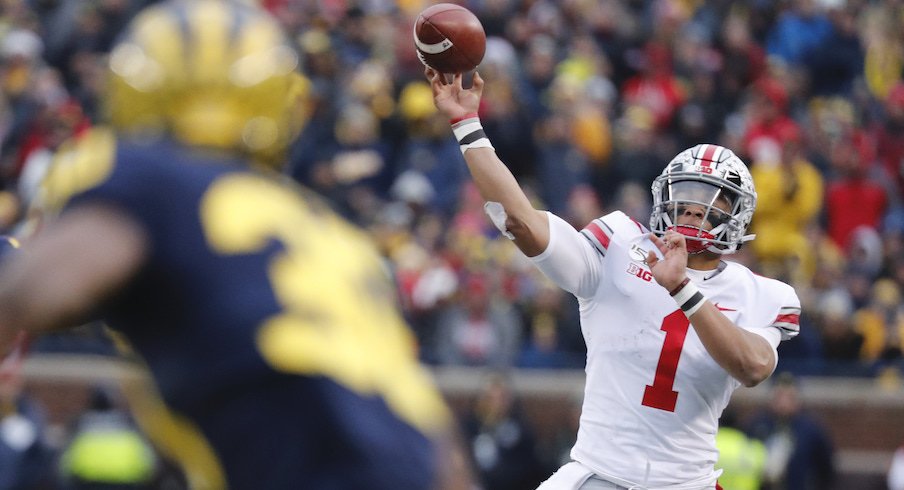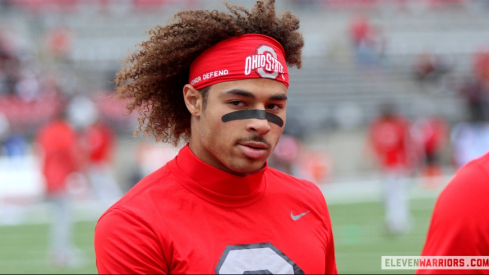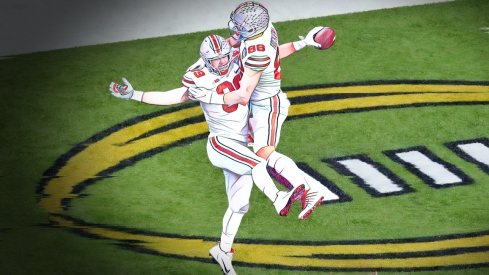Three years, one champion.
Not since 2016 has a Big Ten team based outside of Columbus won a conference championship. Once again, Ohio State will enter the fall as the clear favorite in the conference.
Which teams, though, are set to potentially challenge the Buckeyes atop the Big Ten? With that in mind, we put the entire conference into five tiers.
Tier 1: The Favorite
Ohio State
As the 2020 season nears, the Buckeyes stand alone as the class of the Big Ten.
They bring back Justin Fields as a Heisman Trophy finalist quarterback to lead what has a chance to be the most explosive offense in the country. He'll pair up with Oklahoma transfer Trey Sermon in the backfield, tossing passes to Chris Olave and Garrett Wilson while getting protected by what has a chance to be the nation's top offensive line. Good luck finding any substantial holes in the Buckeyes' offense.
Defensively, the Buckeyes have a lot to replace after Chase Young, Jeff Okudah, Damon Arnette, DaVon Hamilton, Malik Harrison and others bounced to the NFL. But with Pete Werner, Zach Harrison, Sevyn Banks, Josh Proctor, Baron Browning and Jonathon Cooper still in Columbus, Greg Mattison and Kerry Coombs have ample talent to build a defense around.
Right now, there's no debate. Ohio State is the clear favorite to win the conference championship for the fourth year in a row.
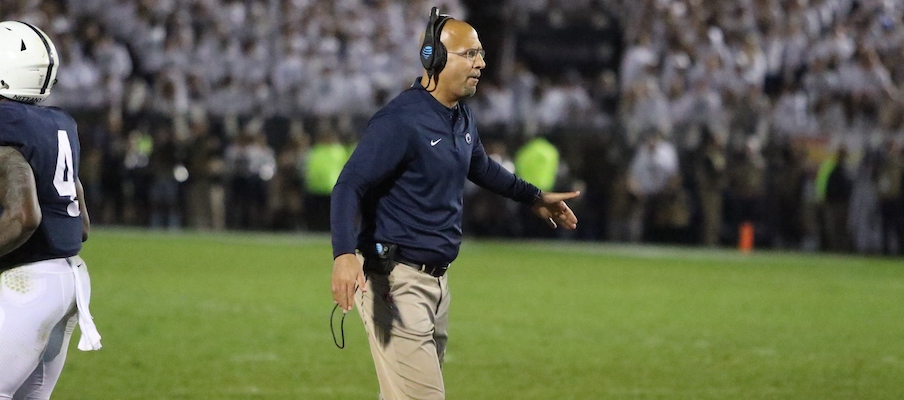
Tier 2: The Contenders
Penn State
James Franklin has led Penn State to 11-win seasons in three of the past four years, and the Nittany Lions haven't won fewer than nine games since 2015. Again, they're expected to be among the Big Ten's best.
A defense that ranked top-10 in points allowed per game last year once again features Micah Parsons, a consensus All-American. A fellow one-time Ohio State recruiting target, defensive end Jayson Oweh, is a breakout candidate after a five-sack sophomore campaign.
The Nittany Lions bring back an offense led by quarterback Sean Clifford, who had an up-and-down first year as a starter. He'll need to improve significantly for Penn State to win a conference title. After losing KJ Hamler, Clifford has an unproven crop of receivers, but he will still have tight end Pat Freiermuth to target. He'll also be playing behind an experienced line and handing the ball off to a strong pair of running backs: Journey Brown and Noah Cain.
Michigan
While Jim Harbaugh hasn't gotten over the hump, neither beating Ohio State nor winning the Big Ten in his five years at Michigan, his teams have won at least eight games every year. Once again, the Wolverines are expected to be among the best teams in the conference, though they're a rung below the Buckeyes.
Shea Patterson's gone, and either Dylan McCaffrey or Joe Milton will replace him. At the skill positions, the Wolverines return running backs Zach Charbonnet and Hassan Haskins, tight end Nick Eubanks and wide receivers Nico Collins and Ronnie Bell to give whoever starts at quarterback some veteran weapons. However, the offensive line's a question mark after Ed Warinner lost four starters.
Defensively, Don Brown has to replace Josh Uche, Khaleke Hudson and Lavert Hill. Aidan Hutchinson and Kwity Paye, each of whom accounted for at least 10 tackles for loss last year, are a quality pair of defensive linemen. Michigan's relying on linebacker Cameron McGrone, safety Dax Hill and cornerback Ambry Thomas to continue their upward trajectory, leading what could be one of the conference's best defenses.
Minnesota
Originally, there was thought about putting Minnesota in a tier of its own just behind Penn State, Michigan and Wisconsin. But after going 11-2 last year, ending the season with an Outback Bowl win against Auburn and bringing a host of key players back for 2020, this team deserves to be viewed alongside that trio.
Led by quarterback Tanner Morgan, Minnesota could be Ohio State's stiffest challenge for having the conference's most prolific offense. He won't have Rodney Smith, last year's starting running back, alongside him anymore, and wideout Tyler Johnson is gone, too. But he'll continue to toss passes to Rashod Bateman, who might be the Big Ten's top receiver. The offensive line also returns all five starters.
The main questions about Minnesota will be centered on how its defense performs after losing safety Antoine Winfield Jr., rush linebacker Carter Coughlin and linebacker Kamal Martin. Only four starters from last year's team are back for the 2020 season.
Wisconsin
No longer is this The Jonathan Taylor Show. Wisconsin moves into a new era without the star running back. But with Paul Chryst bringing back a slew of impact players, the Badgers should be one of the two favorites to win the Big Ten West.
Without Taylor, they'll need improved play out of their quarterback, so is there a chance they move away from senior Jack Coan in favor of redshirt freshman Graham Mertz? That'll be a preseason battle to watch. With Quintez Cephus and Aron Cruickshank gone, the Badgers also have major questions at wide receiver. Wisconsin will also have to figure out its future at running back, whether to go with Garrett Groshek, Nakia Watson or a rotation. They're also replacing Rimington Trophy center Tyler Biadasz.
Defensively, the Badgers also lose a few key starters – namely linebackers Zack Baun and Chris Orr. They return linebacker Jack Sanborn and defensive ends Isaiahh Loudermilk and Garrett Rand, but they'll need more impact players stepping up on that side of the ball to contend for a conference title.
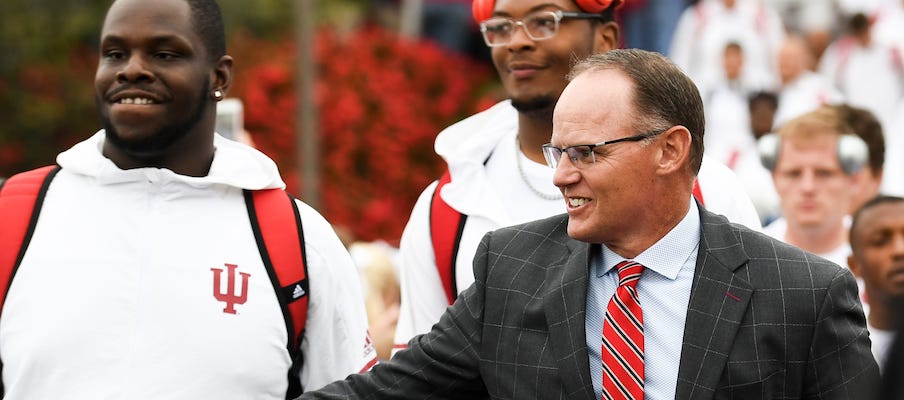
Tier 3: The Mosh Pit
Indiana
Tom Allen's Hoosiers are among a mishmash of teams on the third rung of the conference hierarchy. While often overlooked in the Big Ten, Indiana has an intriguing roster that brings back 17 returning starters, including the quarterback.
Michael Penix Jr. battled a knee injury last year, but in the six games he was healthy enough to play, he showed he can be dangerous as a quarterback in the Big Ten. He's aided by last year's starting running back, Stevie Scott, and 1,000-yard slot receiver Whop Philyor. Indiana's defense returns nine starters after ranking 36th nationally in yards allowed per game.
Nebraska
Is this the year Nebraksa finally breaks through and becomes a true Big Ten challenger? Maybe, but momentum doesn't appear to be on Scott Frost's side right now as he enters Year 3 of a rebuild.
Adrian Martinez is a dynamic quarterback who many viewed as a dark-horse Heisman Trophy candidate a year ago at this time, but he battled both injuries and inconsistency as a sophomore. He returns along with eight other starters on an offense that features wide receiver Wan'Dale Robinson and multiple experienced linemen. On the other side of the ball, Nebraska struggled mightily and will attempt to rebound with a largely new cast of players. It returns just five starters on defense.
Iowa
So much about the Hawkeyes will look different next year after going 10-3 in 2019. Most recently, strength and conditioning coach Chris Doyle departed after a social media outpouring of allegations of racist comments and behavior from former players. There continue to be questions about the future of offensive coordinator Brian Ferentz, too.
On the field, there will be ample turnover, as well. Iowa returns only 12 starters. Quarterback Nate Stanley is gone, and so are offensive tackle Tristan Wirfs and defensive end A.J. Epenesa. Spencer Petras will likely replace Stanley, leading the Hawkeyes forward.
Purdue
Last year, the Boilermakers disappointed, finishing with a 4-8 record in Jeff Brohm's third season. This fall, they'll bring back 17 starters, including All-American wideout Rondale Moore, as they seek to avenge their poor 2019 campaign.
Moore will pair up with fellow receiver David Bell to make up a tantalizing duo. However, the Boilermakers will lose quarterback Elijah Sindelar, forcing them to turn to either Jack Plummer or Aidan O’Connell. Defensively, eight starters are back for 2020, including linebacker Derrick Barnes and defensive end George Karlaftis, who had 7.5 sacks as a freshman last fall.
Michigan State
The Mel Tucker era begins this fall with a roster depleted of most of last season's top players. Brian Lewerke's gone, too, which presumably ushers in Rocky Lombardi as the next starting quarterback.
Some of the biggest changes come on defense, where the Spartans lose a trio of key linemen – Kenny Willekes, Raequan Williams and Mike Panasiuk – and linebacker Joe Bachie. Tucker has his work cut out for him this fall.
Northwestern
The Wildcats' 2018 Big Ten championship game appearance felt far in the past last fall as they slogged their way to a 3-9 record. As Pat Fitzgerald readies for what he hopes will be a bounce-back season, he'll do so with the vast majority of last year's contributors back for 2020.
Northwestern returns 19 starters, the most in the Big Ten, including 10 on offense and nine on defense. Provided Peyton Ramsey wins the starting job, Fitzgerald's offense will have a new quarterback running the show. Ramsey, who comes to town as a graduate transfer from Indiana, will look to improve what was one of the nation's worst offenses, averaging 16.3 points per game last year. On defense, the Wildcats return linebackers Paddy Fisher and Blake Gallagher to lead the way.
Tier 4: The Doormats
Illinois
Lovie Smith once took the Chicago Bears to a Super Bowl, but in four seasons at Illinois, he has yet to reach a .500 record. Last season, he came the closest, with the Illini going 6-7. But since six starters on defense – including linebacker Dele Harding and defensive end Oluwole Betiku Jr. – are gone, Smith has to figure out how to reconfigure the entire defense. A positive? Quarterback Brandon Peters is among nine returning starters on offense. A negative? Illinois lost its top two running backs – Reggie Corbin and Dre Brown – to graduation.
Maryland
To call it a rebuilding job that Mike Locksley inherited would be an understatement. Maryland remains years away from becoming an actual contender in the conference, and the path looks exceedingly difficult. This season, the Terrapins will likely rely on Virginia Tech transfer quarterback Josh Jackson to run an offense bereft of many playmakers after losing their top two running backs. The situation on defense isn't much better after ranking outside of the top-100 in opponent points per game and yards allowed per play last season.
Tier 5: Rutgers
Rutgers
Eventually, Greg Schiano might get things humming up in Piscataway. This, however, is not the year he breaks through.
Just keep chopping.
